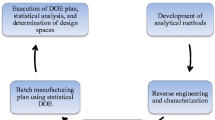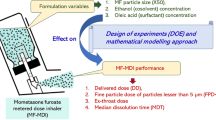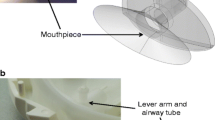Abstract
The performance of pressurized metered dose inhalers (MDIs) is affected by formulation and device variables that impact delivered dose, aerodynamic particle size distribution, and consequently lung deposition and therapeutic effect. Specific formulation variables of relevance to two commercially available products—Proventil® HFA [albuterol sulfate (AS) suspension] and Qvar® [beclomethasone dipropionate (BDP) solution]—were evaluated to determine their influence on key performance attributes measured experimentally with in vitro cascade impaction studies. These commercial MDIs, utilized as model systems, provided mid-points for a design of experiments (DoE) plan to manufacture multiple suspension and solution MDI formulations. The experimental results were utilized as input variables in a computational dosimetry model to predict the effects of MDI formulation variables on lung deposition. For the BDP solution DoE MDIs, increased concentrations of surfactant oleic acid (0–2% w/w) increased lung deposition from 24 to 46%, whereas changes in concentration of the cosolvent ethanol (7–9% w/w) had no effect on lung deposition. For the AS suspension DoE MDIs, changes in oleic acid concentration (0.005–0.25% w/w) did not have significant effects on lung deposition, whereas lung deposition decreased from 48 to 26% as ethanol concentration increased from 2 to 20% w/w, and changes in micronized drug volumetric median particle size distribution (X50, 1.4–2.5 μm) increased deposition in the tracheobronchial airways from 5 to 11%. A direct correlation was observed between fine particle fraction and predicted lung deposition. These results demonstrate the value of using dosimetry models to further explore relationships between performance variables and lung deposition.








Similar content being viewed by others
References
Myrdal PB, Sheth P, Stein SW. Advances in metered dose inhaler technology: formulation development. AAPS PharmSciTech. 2014;15(2):434–55.
Newman SP, Chan H-K. In vitro/in vivo comparisons in pulmonary drug delivery. J Aerosol Med Pulm Drug Deliv. 2008;21(1):77–84.
Finlay WH, Stapleton KW, Zuberbuhler P. Comparisons between inhaled fine particle fractions and lung dose for nebulized aerosols. J Aerosol Med. 1998;11:S65–72.
US Department of Health and Human Services – Food and Drug Administration – Center for Drug Evaluation and Research (CDER). Metered dose inhaler (MDI) and dry powder inhaler (DPI) drug products—chemistry, manufacturing, and controls documentation. In: Guidance for Industry – Draft; 1998.
Smyth HDC, Martonen TB, Isaacs KK, Hickey AJ. Estimation of particle deposition in the airways from different inhaler formulations using an in silico model. KONA Powder Part J. 2011;29:107–16.
Martonen TB. Mathematical model for the selective deposition of inhaled pharmaceuticals. J Pharm Sci. 1993;82:1191–9.
Asgharian B, Hoffmann W, Bergmann R. Particle deposition in a multiple-path model of the human lung. Aerosol Sci Technol. 2001;34:332–9.
Sheth P, Sandell D, Conti DS, Holt JT, Hickey AJ, Saluja B. Influence of formulation factors on the aerosol performance of suspension and solution metered dose inhalers: a systematic approach. AAPS J. 2017;19(5):1396–410.
Stapleton KW, Guentsch E, Hoskinson MK, Finlay WH. On the suitability of k–ε turbulence modeling for aerosol deposition in the mouth and throat: a comparison with experiment. J Aerosol Sci. 2000;31(6):739–49.
Grgic B, Finlay WH, Burnell PKP, Heenan AF. In vitro intersubject and intrasubject deposition measurements in realistic mouth–throat geometries. J Aerosol Sci. 2004;35(8):1025–40.
FDA Draft Guidance on Albuterol Sulfate. Recommended April 2013; Revised June 2013; Revised December 2016.
Roberts DL, Mitchell JP. The effect of nonideal cascade impactor stage collection efficiency curves on the interpretation of the size of inhaler-generated aerosols. AAPS PharmSciTech. 2013;14(2):497–510.
Asgharian B, Price OT, Hofmann W. Prediction of particle deposition in the human lung using realistic models of lung ventilation. J Aerosol Sci. 2006;37:1209–21.
Yu CP. Exact analysis of aerosol deposition during steady breathing. Powder Technol. 1978;21:55–62.
Leach CL, Davidson PJ, Hasselquist BE, Boudreau RJ. Lung deposition of hydrofluoroalkane-134a beclomethasone is greater than that of chlorofluorocarbon fluticasone and chlorofluorocarbon beclomethasone. Chest. 2002;122(2):510–6.
Leach CL, Davidson PJ, Boudreau RJ. Improved airway targeting with the CFC-free HFA-beclomethasone metered-dose inhaler compared with CFC-beclomethasone. Eur Respir J. 1998;12:1346–53.
Howarth PH. Why particle size should affect clinical response to inhaled therapy. J Aerosol Med. 2001;14:S27–34.
Hickey AJ, Martonen TB, Yang Y. Theoretical relationship of lung deposition to the fine particle fraction of inhalation aerosols. Pharmaeutica Acta Helvetiae. 1996;71:185–90.
Vervaet C, Byron PR. Drug–surfactant–propellant interactions in HFA-formulations. Int J Pharm. 1999;186:13–30.
Stein SW, Myrdal PB. The relative influence of atomization and evaporation on metered dose inhaler drug delivery efficiency. Aerosol Sci Technol. 2006;40(5):335–47.
Sheth P, Fazel M, Stein SW, Myrdal PB. Formulation effects on differential throat deposition for pMDIs with USP inlet and Alberta idealized throat. Respir Drug Deliv Proc. 2014;3:631–6.
Ivey JW, Vehring R, Finlay WH. Understanding pressurized metered dose inhaler performance. Expert Opin Drug Deliv. 2015;12(6):901–16.
Stein SW, Sheth P, Myrdal PB. A model for predicting size distributions delivered from pMDIs with suspended drug. Int J Pharm. 2012;422(1):101–15.
Sheth P, Sandell D, Svensson M, Vallorz E, Sullivan JB, Saluja B, et al. The influence of formulation variables on mometasone furoate pMDIs. Respir Drug Deliv. 2016;2:285–90.
Stein SW. Aiming for a moving target: challenges with impactor measurements of MDI aerosols. Int J Pharm. 2008;355:53–61.
Smyth HDC, Hickey AJ. Multimodal particle size distributions emitted from HFA-134a solution pressurized metered-dose inhalers. AAPS PharmSciTech. 2003;4(3):38.
Mitchell J, Newman S, Chan H-K. In vitro and in vivo aspects of cascade impactor tests and inhaler performance: a review. AAPS PharmSciTech. 2007;8(4):E1–E12.
Finlay WH, Stapleton KW. The effect on regional lung deposition of coupled heat and mass transfer between hygroscopic droplets and their surrounding phase. J Aerosol Sci. 1995;26:655–70.
Acknowledgements
Funding for this work was made possible, in part, by the Food and Drug Administration through grant 1U01FD004943-01. Views expressed in this publication do not necessarily reflect the official policies of the Department of Health and Human Services, nor does any mention of trade names, commercial practices, or organization imply endorsement by the US Government.
Author information
Authors and Affiliations
Corresponding author
Ethics declarations
Disclaimer
The opinions expressed in this paper by the authors do not necessarily reflect the views or policies of the Food and Drug Administration (FDA).
Electronic Supplementary Material
ESM 1
(DOCX 612 kb)
Rights and permissions
About this article
Cite this article
Schroeter, J.D., Sheth, P., Hickey, A.J. et al. Effects of Formulation Variables on Lung Dosimetry of Albuterol Sulfate Suspension and Beclomethasone Dipropionate Solution Metered Dose Inhalers. AAPS PharmSciTech 19, 2335–2345 (2018). https://doi.org/10.1208/s12249-018-1071-7
Received:
Accepted:
Published:
Issue Date:
DOI: https://doi.org/10.1208/s12249-018-1071-7




